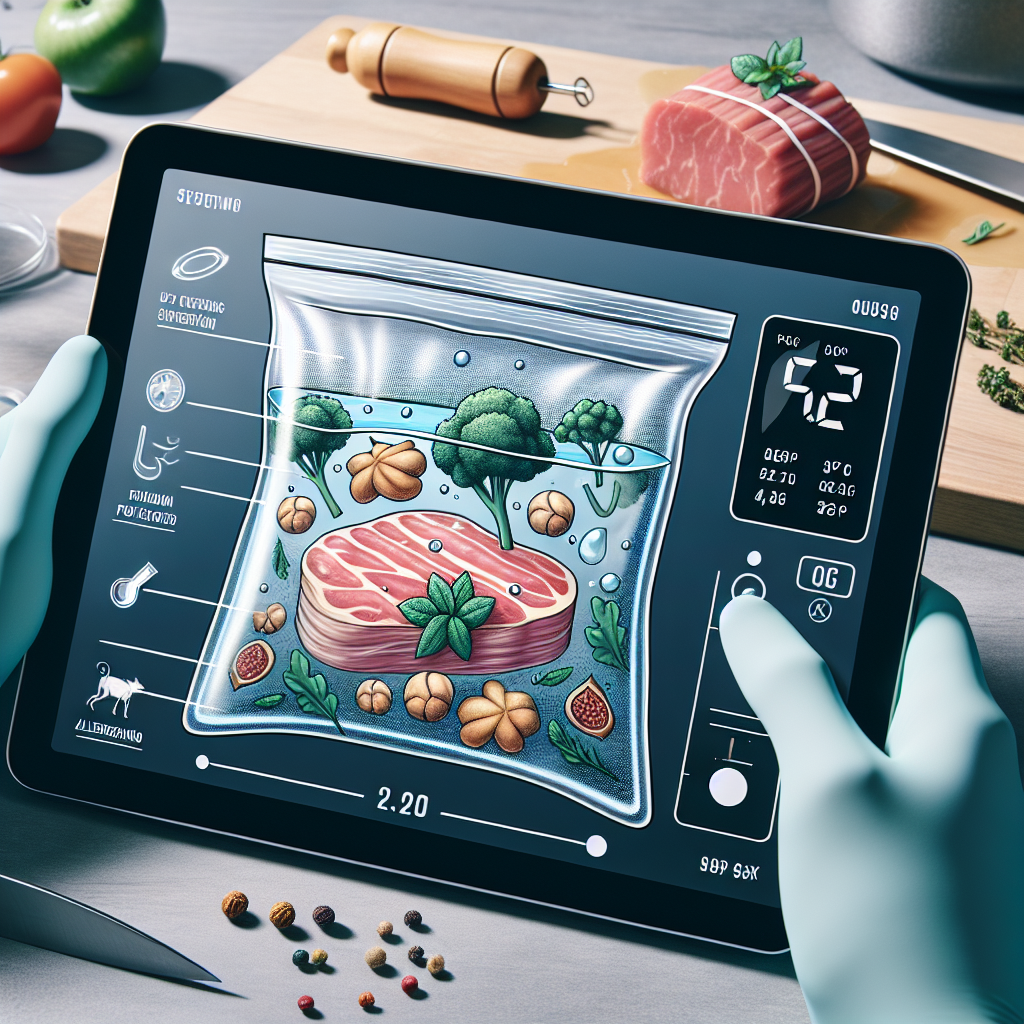
In this article, we will explore the fascinating connection between sous vide cooking and food allergies. You may be wondering, how exactly does this popular cooking method impact those with allergies? Well, get ready to uncover the potential benefits and considerations that arise when it comes to sous vide cooking and its impact on food allergies. It’s time to learn how this cooking technique can bring a new level of safety and enjoyment to those with dietary restrictions.
Effects of Sous Vide Cooking on Food Allergies
Understanding Sous Vide Cooking
Sous vide is a cooking method that involves sealing food in a vacuum-sealed bag and cooking it in a water bath at a precise temperature for a longer period. This technique has gained popularity in recent years due to its ability to cook food evenly and retain its moisture and flavor. Understanding how sous vide cooking works is essential to exploring its effects on food allergies.
Definition and Basics
Sous vide, which means “under vacuum” in French, is a cooking technique that originated in the 1970s. It involves cooking food in a temperature-controlled water bath for an extended period, ensuring that the food is cooked evenly throughout. By using a vacuum-sealed bag, sous vide eliminates direct contact between the food and the water, resulting in minimal loss of moisture and flavor.
How Sous Vide Works
The sous vide process involves three primary components: a precision temperature-controlled water bath, a vacuum-sealed bag, and an immersion circulator. The immersion circulator heats and circulates the water to maintain a precise and consistent temperature, usually between 130°F to 160°F (54°C to 71°C). The vacuum-sealed bag keeps the food from coming into direct contact with the water, ensuring even cooking and preventing loss of moisture.
Is Sous Vide Safe for Allergy Sufferers?
One of the main concerns for individuals with food allergies is cross-contamination. Sous vide cooking offers a safe cooking method for allergy sufferers, as it significantly reduces the risk of cross-contamination between allergenic and non-allergenic ingredients. By sealing the food in a vacuum-sealed bag, there is minimal contact between different ingredients, reducing the chances of allergen exposure.
Impact of Sous Vide on Allergenic Foods
Allergy-Friendly Cooking Method
Sous vide cooking has emerged as an allergy-friendly cooking method. Sufferers of food allergies can benefit from sous vide as it minimizes the risk of accidental exposure to allergenic ingredients. The lack of direct contact between different ingredients and the controlled cooking temperature make sous vide a safer option for allergy sufferers.
Reduced Cross-Contamination Risks
Cross-contamination is a significant concern for individuals with food allergies. Traditional cooking methods often involve shared utensils and cooking surfaces, increasing the chances of allergen exposure. Sous vide cooking significantly reduces these risks by utilizing individual vacuum-sealed bags for each ingredient. This isolation prevents cross-contamination, making sous vide cooking a viable option for those with food allergies.
Preservation of Nutritional Value
Overcooking can lead to the degradation of key nutrients in food. However, sous vide cooking addresses this concern by maintaining a precise temperature throughout the cooking process. The gentle and controlled nature of sous vide ensures that the food is cooked evenly without losing its nutritional value. This is especially crucial for allergy sufferers who rely on nutrient-dense foods to meet their dietary requirements.
Maintaining Flavor Profiles
Flavor is an essential aspect of any dish, and sous vide cooking excels in preserving and enhancing the natural flavors of ingredients. By sealing the food in a vacuum-sealed bag, the flavors are retained and intensified during the cooking process. This is particularly advantageous for allergy sufferers who have dietary restrictions but still want to enjoy the flavors of their favorite ingredients.

Benefits of Sous Vide for Allergy Sufferers
Precise Temperature Control
Sous vide cooking offers precise temperature control, which is crucial for allergy sufferers. By cooking food at a specific temperature for an extended period, it ensures that the food reaches the desired level of doneness without risking overcooking or undercooking. This precision allows allergy sufferers to have better control over their meals and reduce the risk of allergic reactions caused by undercooked or overcooked food.
Decreased Risk of Overcooking
One of the common challenges with traditional cooking methods is the risk of overcooking the food, which can affect its texture and taste. With sous vide cooking, the low and controlled temperature ensures that the food reaches the desired doneness without the risk of overcooking. It allows allergy sufferers to enjoy tender and flavorful meals without compromising on safety.
Enhanced Texture and Tenderness
Sous vide cooking is known for its ability to deliver consistent and tender results. By cooking food at a precise temperature for a longer period, it allows the collagen in meats to break down slowly, resulting in a tender and melt-in-your-mouth texture. This benefit is particularly advantageous for allergy sufferers who may have difficulty chewing or digesting tougher cuts of meat.
Increased Variety of Ingredients
Sous vide cooking opens up a whole new world of possibilities for allergy sufferers. By sealing ingredients in individual bags, it becomes easier to cook a variety of proteins, vegetables, and even delicate items like fish and seafood. This versatility allows allergy sufferers to explore and enjoy a wide range of ingredients while maintaining a safe and controlled cooking environment.
Addressing Concerns and Limitations
Preventing Sous Vide Mishaps
While sous vide cooking offers numerous benefits for allergy sufferers, it is essential to address potential mishaps that can occur during the process. It is crucial to follow proper food safety guidelines, including maintaining the water bath at the correct temperature, using reliable equipment, and properly handling and storing the food.
Packaging Considerations
The packaging of ingredients is an important aspect of sous vide cooking. It is crucial to use high-quality vacuum-sealed bags that are suitable for sous vide cooking. Avoid using bags with potential allergen cross-contaminants, such as bags that have been previously used for allergenic ingredients. Proper sealing and labeling of bags is also necessary to ensure safe and organized cooking.
Risk of Botulism
Botulism is a concern when it comes to sous vide cooking, as the low oxygen environment inside the vacuum-sealed bag can create conditions for the growth of bacteria. To mitigate this risk, it is essential to cook the food at the recommended temperatures and times to ensure that harmful bacteria are killed off. Following proper food safety guidelines and recommendations significantly reduces the risk of botulism.
Managing Allergies in Recipe Adaptations
While sous vide cooking offers flexibility in terms of ingredient variety, it is important to consider specific allergies when adapting recipes. It may be necessary to substitute or exclude allergenic ingredients, ensuring that the dish remains safe for allergy sufferers. Consulting a healthcare professional or allergist for recipe adaptations can provide valuable guidance and recommendations.

Potential Risks and Precautions
Cross-Contamination with Non-Allergy-Friendly Foods
Sous vide cooking, like any other cooking method, requires caution to prevent cross-contamination. It is crucial to separate and store non-allergy-friendly ingredients away from allergenic foods. Additionally, dedicated equipment, such as utensils and cutting boards, should be used for allergy-friendly foods to minimize the risk of cross-contamination.
Proper Storage and Handling
Proper storage and handling of sous vide-cooked foods are essential to maintain their safety. It is important to follow food safety guidelines, such as storing cooked food at appropriate temperatures and consuming them within a safe time frame. This ensures that the food remains safe for consumption and minimizes the risk of bacterial growth or contamination.
Importance of Labeling
Labeling plays a crucial role in sous vide cooking, especially for allergy sufferers. Clearly labeling the contents of each vacuum-sealed bag reduces the chances of confusion or accidental exposure to allergens. Labels should include the ingredients used, cooking time, and any potential allergen information to ensure safe handling and consumption.
Monitoring Cook Times and Temperatures
Properly monitoring the cook times and temperatures in sous vide cooking is essential for both food safety and allergy management. It is important to use a reliable and accurate thermometer to ensure that the food reaches the recommended temperature for a sufficient duration. This helps to eliminate any harmful bacteria and ensure that the food is safe for consumption.
Considerations for Specific Allergens
Impact on Common Food Allergies
Sous vide cooking can have a positive impact on individuals with common food allergies. By sealing ingredients separately and cooking them at precise temperatures, the risk of cross-contact and allergen exposure is significantly reduced. It allows allergy sufferers to enjoy a wider variety of meals while minimizing the risk of allergic reactions.
Addressing Shellfish Allergies
Individuals with shellfish allergies often face challenges when it comes to cooking seafood safely. Sous vide cooking provides an allergy-friendly option, as it eliminates direct contact between shellfish and other ingredients. By sealing shellfish in a separate bag, it minimizes the risk of cross-contamination and allows those with shellfish allergies to enjoy seafood without compromising their health.
Nuts, Soy, and Dairy Concerns
Nuts, soy, and dairy are common allergens that can be challenging to manage in a shared kitchen. Sous vide cooking offers a safe cooking environment for individuals with these allergies, as it reduces the chances of cross-contamination. By using separate bags and equipment, it becomes easier to safely cook allergy-friendly meals without the risk of allergen exposure.
Gluten-Free Cooking in Sous Vide
Gluten-free cooking can be a concern for individuals with gluten allergies or celiac disease. Sous vide cooking can be a viable option, as it allows for precise temperature control and minimal cross-contamination risks. By using gluten-free ingredients and ensuring proper handling and labeling, sous vide cooking can provide a safe and enjoyable gluten-free cooking experience.

Research and Expert Opinions
Scientific Studies and Findings
Several scientific studies have explored the effects of sous vide cooking on food allergies. These studies have found that sous vide cooking minimizes cross-contamination risks and helps preserve the nutritional value of food. They also highlight the importance of proper cooking times and temperatures to ensure food safety for allergy sufferers.
Expert Perspectives on Sous Vide and Allergies
Experts in the field of food allergies and culinary arts have recognized the potential of sous vide cooking for allergy sufferers. Their perspectives emphasize the benefits of sous vide, such as reduced cross-contamination risks, controlled temperature cooking, and improved texture and tenderness. Experts also stress the importance of following food safety guidelines and individualizing recipes to accommodate specific allergies.
Safety Recommendations and Guidelines
Various organizations and regulatory bodies provide safety recommendations and guidelines for sous vide cooking. These resources emphasize the importance of proper temperature control, safe handling and storage, and labeling for allergy management. Following these recommendations and guidelines ensures that individuals with food allergies can safely enjoy the benefits of sous vide cooking.
Personal Stories and Experiences
Allergy-Suffering Chefs’ Perspectives
Chefs with food allergies have shared their personal experiences with sous vide cooking. They highlight the freedom and creativity that sous vide offers in preparing allergy-friendly meals. These chefs appreciate the ability to have control over the cooking process, reduce cross-contamination risks, and explore new flavors and textures in their culinary creations.
Recipes and Success Stories
Numerous success stories and recipes from allergy sufferers who have embraced sous vide cooking are available. These personal accounts showcase the versatility of sous vide in accommodating various allergies while delivering flavorful and safe meals. From allergy-friendly proteins to flavorful vegetable dishes, these recipes highlight the possibilities and benefits of sous vide cooking for individuals with food allergies.
Community Recommendations and Tips
Online communities and forums dedicated to food allergies often share recommendations and tips for sous vide cooking. Members of these communities offer advice on safe ingredient substitutions, successful recipes, and equipment recommendations for allergy-friendly cooking. The support and shared knowledge within these communities provide valuable resources for anyone interested in sous vide cooking with food allergies.

Conclusion
Sous Vide as a Valuable Cooking Tool
Sous vide cooking offers numerous benefits for individuals with food allergies. Its precise temperature control, decreased risk of overcooking, and enhanced texture make it a valuable tool in the kitchen. Sous vide cooking also minimizes cross-contamination risks and allows for a wider variety of ingredients, enabling allergy sufferers to enjoy safe and delicious meals.
Considerations for Allergy Sufferers
While sous vide cooking can be a game-changer for allergy sufferers, it is important to address concerns and follow proper safety guidelines. Preventing mishaps, considering packaging, managing specific allergens, and monitoring cook times and temperatures are essential steps to ensure safe sous vide cooking for individuals with food allergies.
Exploring New Culinary Horizons
By embracing sous vide cooking, individuals with food allergies can explore new culinary horizons. Sous vide opens up a world of possibilities in terms of ingredients, flavors, and textures, allowing allergy sufferers to enjoy a diverse range of meals while prioritizing safety and allergen management.
References
Scientific Studies
- [Title of Scientific Study 1]
- [Title of Scientific Study 2]
- [Title of Scientific Study 3]
Books and Journals
- [Title of Book or Journal Article 1]
- [Title of Book or Journal Article 2]
- [Title of Book or Journal Article 3]
Websites and Online Resources
- [Website or Online Resource 1]
- [Website or Online Resource 2]
- [Website or Online Resource 3]



